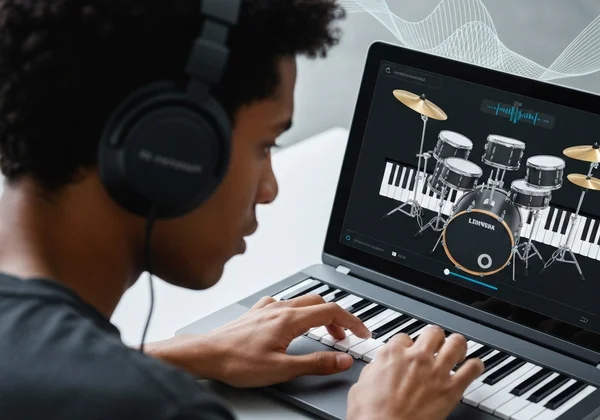Learn Drums Online with Your Virtual Drum Set: The Ultimate Beginner's Guide
Have you ever dreamed of laying down a powerful beat, but the thought of expensive drum kits, angry neighbors, and limited space stopped you in your tracks? If you've ever tapped your fingers on a desk or air-drummed to a classic rock anthem, your rhythm journey is waiting to begin. This ultimate guide is your free ticket to learn drums online, starting from scratch and without any barriers. So, Can you learn drums online? Absolutely, and we're about to show you how with a powerful, free tool you can use right now. Get ready to unleash your inner drummer with our amazing virtual drums!
Getting Started with Your Virtual Drum Set
Before you can rock out, you need to get familiar with your instrument. The best part? Your new drum set is already in front of you—it's your computer or phone! An online drum kit removes all the physical hurdles, giving you instant access to a full percussion setup.
What is a Virtual Drum Kit and How Does it Work?
A virtual drum kit is an interactive, digital simulation of a real drum set that you can play directly in your web browser. Instead of drumsticks, you use your keyboard keys or mouse clicks to trigger high-quality, realistic drum sounds. There’s nothing to download or install. You simply visit the website, and the drum kit is ready for you to play. It's the most accessible way to start learning and practicing rhythms anytime, anywhere.

Meet Your Drum Kit: Parts of a Drum Set Explained
A standard drum set can look intimidating, but it’s just a collection of different percussion instruments. Here are the core components you’ll find on our online drum kit:
- Bass Drum (or Kick Drum): The big drum on the floor, played with a foot pedal. It creates the deep, thumping "boom" that forms the foundation of most beats.
- Snare Drum: This is the heart of the beat, producing a sharp, snappy "crack." It sits between the drummer's knees.
- Hi-Hats: A pair of cymbals mounted on a stand. They can be played closed for a crisp "chick" sound or open for a sizzling "tssh."
- Tom-Toms (or Toms): These are the drums used for fills and rolls. They come in different sizes to produce a range of pitches, from high to low.
- Crash Cymbal: A large cymbal used for accents, creating a loud, explosive "crash" sound that marks key moments in a song.
- Ride Cymbal: Another large cymbal, typically used for keeping a steady rhythmic pattern, producing a sustained "ping" sound.
Setting Up: Your Keyboard as a Drum Kit for Easy Play
One of the best features of our platform is its intuitive keyboard mapping. Each part of the drum kit corresponds to a specific key on your keyboard. This allows for keyboard drumming, a fun and surprisingly effective way to practice coordination. Simply click the "Show Key" button on the screen, and you'll see which key triggers which sound. For example, 'x' might be your bass drum and 's' your snare. This direct, tactile feedback is perfect for building muscle memory.

Your First Steps: Basic Drumming Techniques & Coordination
Now that you know your way around the kit, it's time to work on the fundamentals. Good technique starts with comfort and coordination. While you aren't holding sticks, proper finger placement and rhythmic understanding are still key.
Finding Your Grip: Comfortable Hand Position for Keyboard Playing
There's no single "correct" way to position your hands for keyboard playing, but comfort is essential. Try resting your fingers on the home row, just like you would for typing. Assign your strongest fingers (like your index and middle fingers) to the most common drums, such as the snare and hi-hat. Keep your hands relaxed to avoid fatigue. The goal is to make hitting the keys feel natural and effortless.
Building Hand-Foot Coordination with Simple Exercises
Drumming is a full-body activity that demands hand-foot coordination. On a virtual kit, we simulate this by coordinating different fingers. Start with a simple exercise:
- Press the bass drum key ('x') with your left hand at a steady pace: Boom... Boom... Boom... Boom...
- Now, add the hi-hat key ('i') with your right hand on every beat, right along with the bass drum: Boom/Chick... Boom/Chick... Boom/Chick... Boom/Chick...
- Finally, add the snare drum key ('s') with your left hand on beats 2 and 4. The pattern will sound like this: Boom/Chick... Crack/Chick... Boom/Chick... Crack/Chick...
Practice this slowly until it feels smooth. You can do this right now on our free drum machine!
Essential Rhythm Fundamentals: Understanding Beats and Timing
The foundation of all music is rhythm. Most popular music is in 4/4 time, which means there are four beats in every measure. Think of it as counting "1, 2, 3, 4" over and over again. The basic rhythm exercises you practice should focus on keeping a steady pulse. Use an online metronome or just tap your foot as you play to develop a solid sense of timing.
Play Your First Beat: Learning Basic Drum Rhythms
This is where the real fun begins! You're about to learn your very first beat—a rhythm you've heard in thousands of songs. This simple pattern is the gateway to playing along with your favorite music.
The Iconic "Rock Beat 101": Your First Rhythm on Virtual Drums
This is the quintessential rock beat. Let's break it down into four simple steps using the coordination exercise from before. Head over to the virtual drums and get ready.
- Hi-Hat: Play steady eighth notes on the hi-hat. That means two hi-hat hits for every beat. Count it as "1 and 2 and 3 and 4 and..."
- Bass Drum: Add the bass drum on beats 1 and 3.
- Snare Drum: Add the snare drum on beats 2 and 4.
- Put it all together! It should sound like "Boom-tish-chick-tish-Crack-tish-chick-tish."
Congratulations! You're officially playing one of the most important basic drum rhythms in modern music.

Adding Dynamics: Mastering Hi-Hat Techniques and Variations
To make your beats more interesting, try varying the hi-hat. Instead of just playing closed hi-hats, try using the open hi-hat key for a sizzling sound on the "and" of beat 4. This little change adds a burst of energy and prepares you for the next measure. Experiment with different hi-hat patterns to see how they change the feel of the groove.
Simple Drum Fills for Beginners: Adding Excitement to Your Beat
A "fill" is a short rhythmic pattern that breaks up the main beat, often used to transition between sections of a song. A very simple fill for beginners is to play four quick notes on the snare drum at the end of a four-bar phrase. For example: play your rock beat three times, and on the fourth time, play the beat for the first three counts, then hit the snare four times on beat 4. These drum fills for beginners make your playing sound more professional and exciting.
Effective Practice Strategies for Online Drummers
Consistency is the key to improvement. Even short, focused practice sessions can make a huge difference. With a tool as accessible as a virtual drum set, you have no excuse not to get your daily rhythm fix.
Structured Practice Sessions: Making the Most of Your Time
You don't need hours to practice effectively. Try this 15-minute routine:
- 5 minutes: Warm up with simple coordination exercises.
- 5 minutes: Practice your main beat, focusing on keeping the timing perfect.
- 5 minutes: Play along to a slow or mid-tempo song you love.
This structured approach ensures you're building both technical skill and musicality.
How to Practice Drums Without a Drum Set: Leveraging Virtual Drums
This is one of the most common questions from aspiring drummers, and the answer is simple. You can absolutely practice drums without a drum set by using an online simulator. A tool like this online drum set is perfect because it helps you develop crucial skills:
- Timing and Rhythm: You can practice keeping a steady beat.
- Coordination: The keyboard mapping forces you to coordinate your fingers, which translates to hand-foot coordination.
- Musicality: You can learn song structures and when to play fills.
- Inspiration: It's a risk-free way to experiment and create your own beats.
Learning Songs: Playing Along with Your Favorite Tracks
The ultimate goal for many drummers is to play along with their favorite bands. Start with simple songs. Pull up a track on YouTube or Spotify, put on your headphones, and try to find the basic beat. Don't worry about getting it perfect. The goal is to listen deeply and connect your playing to the music. This is the most rewarding way to practice online and see your progress come to life.

Your Journey from Zero to Your First Song Starts Now!
Ready to ignite your rhythm? We've covered the essentials: from understanding your virtual drum set to nailing your first beat and smart practice strategies – all free, all now. The only missing piece? You! Your drumming journey begins with a single click.
Don't wait! Every drumming legend started somewhere. Make today your day. Dive into our virtual drums, feel the groove, and unleash the incredible drummer within!
Frequently Asked Questions for Aspiring Drummers
How can I play drums on a computer keyboard effectively?
Playing drums on a computer keyboard is all about practice and muscle memory. Use the "Show Key" feature on our site to learn the layout. Start slowly with basic beats, focusing on clean timing. As you get more comfortable, your fingers will naturally find the right keys, allowing you to play more complex rhythms and fills.
Is it truly possible to learn drums online for free?
Yes! With resources like our online drums, it's entirely possible to learn the fundamentals of drumming for free. Our platform gives you the tool to practice coordination, timing, and basic beats. Combined with free online tutorials, you can build a solid foundation before ever touching a physical kit.
What is the best virtual drum set for a complete beginner?
The best virtual drum set for a beginner is one that is simple, accessible, and has realistic sounds. This virtual drum set is designed specifically for this purpose. It requires no login or installation, features an intuitive keyboard layout, and works on any device, making it the perfect starting point for anyone new to drumming. Give it a try and see for yourself!
How can I practice drums and improve my skills without a physical drum set?
You can practice drums and improve your skills by focusing on core concepts. Use an online drum kit to work on your timing with a metronome, master new rhythms and beats, practice coordination exercises, and play along to songs. This builds the foundational skills you need to become a great drummer.
Am I too old or young to start learning drums?
Absolutely not! Drumming is for everyone, regardless of age. Rhythm is a universal language. The beauty of learning with a free virtual drum set is that it's a pressure-free environment to explore your passion for music at any stage of life. It is never too late or too early to start.